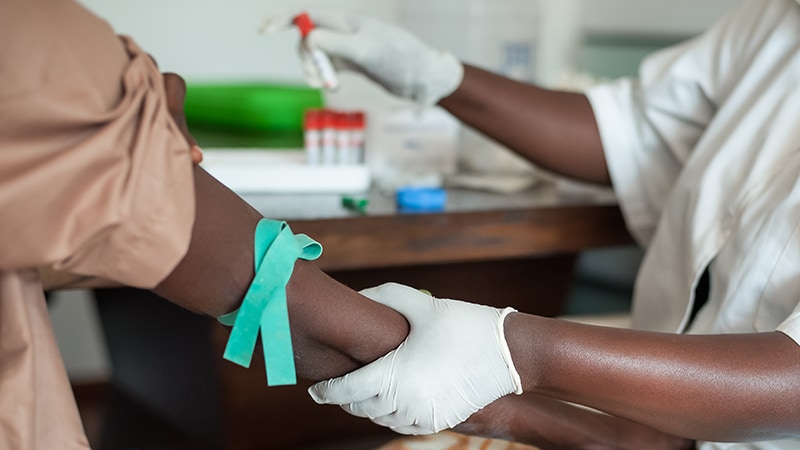Limited healthcare access and sociostructural factors were stronger predictors of HIV than behavioral risk factors among Black women in the southern United States, based on modeling data from more than 300,000 women in or near Atlanta, Georgia. The findings were presented in a late-breaker study at the International AIDS Society Conference on HIV Science.
Nonbehavioral factors such as structural and social determinants of health can complicate HIV risk assessment, wrote Meredith Lora, MD, of Emory University, Atlanta, and colleagues. Previous risk prediction models have underperformed in Black women, whose HIV risk is approximately 20 times that of White women, the researchers wrote.
To better assess HIV risk in Black women, the researchers used machine learning to create a model that analyzed electronic medical records data from all women treated at a single center in Atlanta between 2012 and 2022. The study population included 333,263 women; 617 (0.19%) had incident HIV diagnoses and 89% of those with HIV identified as Black individuals.
The model included features with a prevalence of 5% or higher in the electronic medical records data and included novel structural determinant features and healthcare utilization features.
Overall, the top predictors of HIV included younger age, Black race, residing in high HIV incidence zip codes, and at least one change in phone number or address prior to HIV diagnosis. In addition, women who underwent more HIV screening tests were more likely to be diagnosed with HIV, and women with HIV were more likely than those without HIV to seek care in an emergency department (ED) vs primary care or women’s healthcare settings. Although more women with HIV tested positive for sexually transmitted infectious compared to those without HIV in the 2 years before diagnosis, “seeking sexual health was more important to the model than STI positivity,” the researchers wrote.
The model achieved a test area under the receiver operating characteristic curve (AUROC) of 0.90 and area under a precision-recall curve (AUPRC) of 0.14.
The appearance of frequent HIV testing as a predictor of risk suggests the presence of undisclosed risk factors that may merit further investigation, the researchers noted in their abstract.
EHR models designed for racially diverse female populations may identify more candidates for pre-exposure prophylaxis (PrEP), but that is not enough, the researchers emphasized. “Evaluating how these models are implemented to support PrEP uptake and behavior change is critical for real-world impact,” they concluded.
Assistance in Risk Assessment
The current study is important given the traditional and historical difficulty of women in the United States in predicting their own risk of HIV, said Monica Gandhi, MD, director of the University of California San Francisco Bay Area Center for AIDS Research, and a professor of medicine at UCSF, in an interview.
Gandhi cited a recent study from the CDC showing that more than 2.2 million individuals in the US need PrEP, but only 336K have received prescriptions. “Women may not be able to adjudicate their own risk of HIV, as that risk depends on the risk in their male sexual partners,” said Gandhi, who was not involved in the current study or the CDC study.
“Machine learning using electronic medical records [EMR] can make risk prediction more accurate by reporting both health and social factors,” she noted. The current study identified predictors of HIV risk using extracted EMR data, that the healthcare system may be able to mitigate, she said.
“I was surprised by the fact that seeking sexual health was a stronger predictor of HIV than STD positivity, which indicates that women actually are more aware of their risk for HIV in the US than suggested in previous studies that usually involved smaller sample sizes, Gandhi told Medscape Medical News. “I was also surprised that women with frequent changes in address or phone number had higher risk,” she said. This suggests mobility as a risk factor, which has been identified more commonly in sub-Saharan Africa, she noted. However, Gandhi was not surprised by the preference for ED care or the increased HIV risk among Black women vs other races, both of which have implications for HIV prevention, she said.
The preference for sexual health care in the ED setting in the study population suggests that the ED is an important setting in which to perform STD testing and start PrEP or set up an individual with HIV prevention services, said Gandhi. “Designated PrEP services for women in historically Black neighborhoods are indicated, and women who are mobile and change their address or phone number frequently should be counseled on HIV prevention modalities, specifically PrEP,” she added.
Looking ahead, qualitative research is needed to ask a subset of women with HIV who presented to the ED for sexual health services why they chose the ED; this could help inform how to re-engage women in care, Gandhi said. Additional research on women’s knowledge of PrEP and whether women with HIV were offered PrEP in the past also would help identify more opportunities for HIV prevention, she said.
The study was supported by the Emory Medical Care Foundation and statistical analysis was supported by the National Center for Advancing Translational Sciences. Lora disclosed research support from Viiv Healthcare through funds paid to Emory. Gandhi had no financial conflicts to disclose.
